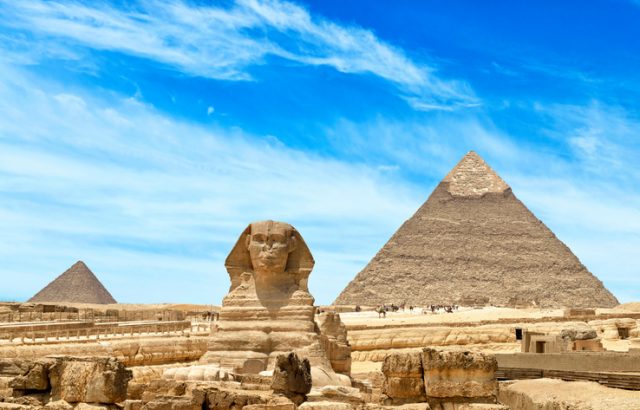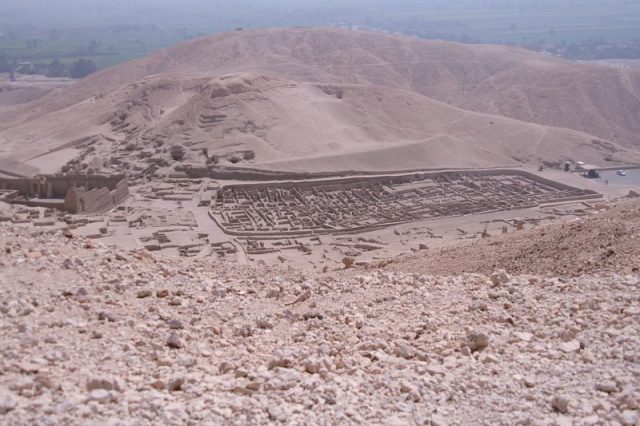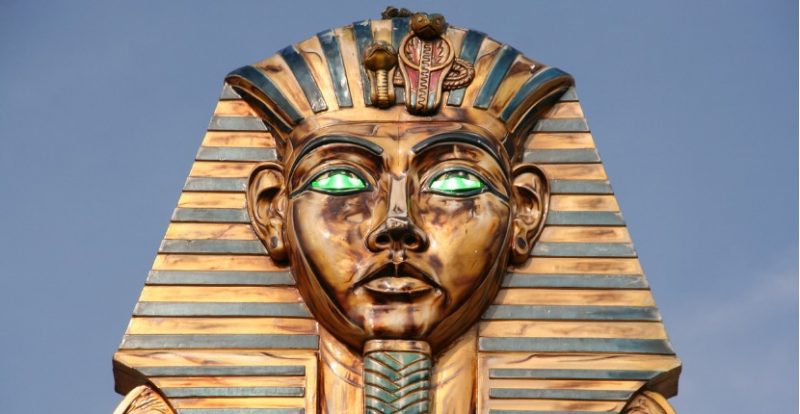As viewers of Hollywood movies know, when an explorer enters an Egyptian tomb they need to keep their head. Quite literally. For it’s only a matter of seconds before a blade swings out to take it off, or worse. Indiana Jones regularly faced his legendary fear of snakes. Lara Croft dodged many a poison dart. This fictionalized version of history has exerted a powerful hold on audiences over the years.
As for the truth of the matter, the jury’s still out. While generally acknowledged that ingenious booby traps are a screenwriter’s embellishment of Ancient Egypt, it hasn’t stopped people looking. As recently as 2016, the Great Pyramid of Giza was being examined for evidence of what appeared to be a giant trap, or as the Daily Mail reported a “primitive machine”.

Believed to have been designed in order to protect the tomb of King Khufu (2589–2566 BC), the “builders built grooves into a small room outside the chamber where the King’s body would be placed. Granite slabs would have then been dropped down into these when the work finished to block off access to the chamber. Three other giant granite blocks were slid down a ramp to the passageway below to cut off access to the inner sanctum.”

The mystery behind the Giza Pyramid’s elaborate structure and what secrets it may protect is ongoing. Some theorize Khufu’s final resting place has remained undiscovered inside, and the idea of large stones crushing people brings to mind that famous “giant ball” sequence in Raiders Of The Lost Ark. However, as with any exploration that captures the public imagination, the reality is usually a letdown. Evidence suggests the groove and slab system didn’t work, with thieves appearing to have accessed and raided the tomb area.

Where did the writers of Dr. Jones’ exploits get their ideas from? There were moveable elements inside the structure that could easily be interpreted as the ultimate deterrent. Architecture has apparently been transformed into something ominous and fatal. There is certainly a compelling narrative behind the plunder of the Pyramids, but it lies more in the class system and how the ancient world operated, rather than fanciful booby traps.
The website Today I Found Out remarked in 2018 that “every level of society took part in it, including somewhat hilariously, the very people charged with constructing the tombs, as well as those in charge of burying the dead.”

With the all-powerful Pharaohs running the show, getting their hands on valuable assets simply wasn’t a problem. The site says, “the pharaoh’s own subjects and in some cases, their direct successors were the ones stealing their afterlife retirement plan,” with outrageous tales such as “pharaohs unceremoniously having the mummy of their predecessor dumped out of their sarcophagus so that even that container could be reused.”
When it came to making off with the Pharaoh’s treasure, it seemed there was one rule for the wealthy and another for everyone else. There were excruciating and example-making ends in store for mere mortals who dared put their eyes on the prize. Being engulfed in flames was seen as particularly brutal. In religious terms it sent the unlucky pilferer to the afterlife without a body.

Even the establishment of a citizen police force of sorts failed to keep the amulets and chariots safe. An entire village called the Place of Truth (or Set Ma’at/Deir el-Medina) was set to work constructing tombs for the highest in society.
The brainchild of Pharaoh Amenhotep, it operated on the principle that villagers would be beholden to the state and hence loyal. This didn’t work out due to reported shoddy treatment of the workforce. There were no strikes but plenty of tomb raiding to balance injustices.

It was a losing battle to keep determined burglars away from the Pharaoh’s precious possessions. Arguably the strongest weapon in their arsenal were those infamous curses, yet the amount of theft appears to suggest people wanted to fill their pockets with cash rather than their souls with fear. Nevertheless, the concepts of ever-weirder booby traps continues to endure in popular culture.
Even the ground beneath their feet was a hazard. As a 2013 Buzzfeed article put it, the floors of tombs could be coated in “hematite powder, a sharp metallic dust designed to cause a slow and painful death to those who inhaled enough of it… When Dr. Zahi Hawass… entered the Bahariya Oasis tomb in 2001, his team found the sarcophagus booby-trapped with 8 inches of the stuff, forcing them to abandon their expedition until they could come back with hazmat suits and respirators.”
Across in China, there are stories of underground mercury lakes, created on the order of Emperor Qin Shi Huang. Could that mean there are long-buried traps of Ancient Egypt waiting to be stumbled upon by unwary archaeologists? Like Indy, they’d better make sure their hats are pulled down tight.
